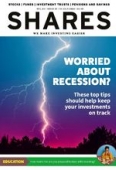Archived article
Please note that tax, investment, pension and ISA rules can change and the information and any views contained in this article may now be inaccurate.
How to find the important information on US shares

Anyone interested in US-listed stocks might find themselves confused when trying to read the latest company announcements. Unless you know the difference between an 8-K and a 10-Q form, trying to fathom what each announcement means is a nightmare.
In the UK, most stock exchange announcements have titles which summarise their content, such as annual report, trading update or director dealings.
In the US, you’re just presented with a list of codes. For example, banking provider Citigroup (C:NYSE) issued five announcements in May all with the title ‘2022 8-K’. That’s gobbledygook to most people. Even when you click on the announcements it takes ages to find out the important pieces of information.
The blame can be laid on the US stock market regulator, the SEC (Security and Exchange Commission). Its forms read more like legal documents than information that is crucial to investors.
THE FORMS THAT MATTER
To help you better understand the different forms we will now go through the important ones.
The key forms to spot are the 10-K which is the annual report, the 10-Q which is a quarterly earnings report and the 8-K which is a material event report which companies must file if they have something very important to tell shareholders.
Another useful form is the 13-F which mutual funds and hedge funds must file at the end of each quarter with a list of their holdings.
WHERE DO I START?
The first place to look for documents is the SEC’s website where you can find the EDGAR (Electronic Data Gathering, Analysis and Retrieval) system and search for reports.
EDGAR contains millions of company filings and is free to access, you simply go to the search page and type in the name of the firm
If we look up tech giant Microsoft (MSFT:NASDAQ), for example, the site brings up a list of the latest filings and a list of selected filings.
As the image overleaf shows, the firm released an 8-K report last month and its last quarterly 10-Q report was filed in April. Clicking on the box marked ‘Filing’ brings up the relevant document.
If you want to sift through all of Microsoft’s 10-Q quarterly filings or 10-K annual filings, you can bring them up by clicking on the relevant box to the right.
Reading the 8-K filing is also important as in the case of Microsoft it reveals the company recently cut its revenue and earnings guidance for the full year due to unfavourable exchange rates in the final quarter to May, and the filing includes a slide deck explaining the revised forecast.
KEEPING UP WITH THE EXPERTS
One of the other most widely watched filings each quarter is the 13-F form which all US-domiciled funds with $100 million or more in assets under management must publish.
The quarterly filing by Berkshire Hathaway (BRK.B:NYSE) is one of the most popular documents as it gives followers of legendary investor Warren Buffett a chance to see what the great man has been buying and selling.
The simplest way to access the 13-F filings is to go to the website 13f.info and enter the name of the manager or the fund you want to look up.
For Berkshire Hathaway, you can find all the 13-F filings dating back to the third quarter of 2013 including separate filings each time the fund added a new stock or multiple stocks.
By comparing the quarterly filings, you can build up a picture of what changes have been made to the portfolio and how the weightings within the portfolio have changed over time.
Unsurprisingly, given the level of interest in Buffett’s investing habits, there are also various websites such as Gurufocus and Whale Wisdom which regularly scrutinise Berkshire’s 13-F filings.
Even ratings agency Morningstar analyses Berkshire’s 13-F filings and flags the latest buys and sells.
Other big-name investors whose 13-F filings are closely watched in case they throw up some unknown gems include Ray Dalio of Bridgewater, Seth Klarman of Baupost Group and Howard Marks of Oaktree Capital.
Hedge fund managers like David Tepper of Appaloosa Management, Ken Griffin of Citadel, Steven Cohen of Point72 and Chris Hohn of TCI also have a large number of followers who are eager to know which stocks they are backing and which ones they are shorting.
Important information:
These articles are provided by Shares magazine which is published by AJ Bell Media, a part of AJ Bell. Shares is not written by AJ Bell.
Shares is provided for your general information and use and is not a personal recommendation to invest. It is not intended to be relied upon by you in making or not making any investment decisions. The investments referred to in these articles will not be suitable for all investors. If in doubt please seek appropriate independent financial advice.
Investors acting on the information in these articles do so at their own risk and AJ Bell Media and its staff do not accept liability for losses suffered by investors as a result of their investment decisions.
Issue contents
Education
Feature
Great Ideas
News
- Collapse of Elon Musk’s Twitter deal could spark Tesla share price recovery
- Kistos aims for £1 billion tie-up with Serica to create North Sea oil and gas champion
- The 2022 AGM season is seeing shareholder rebellions on pay gather pace
- The big US companies reporting over the next week and what it could mean for the economy
- Latest Fundsmith letter offers investors comfort despite tough market conditions

 magazine
magazine









